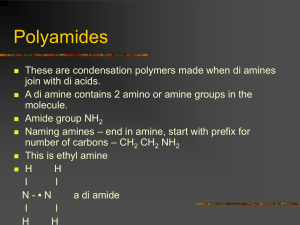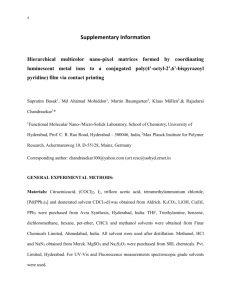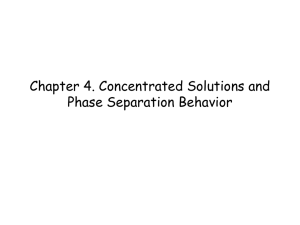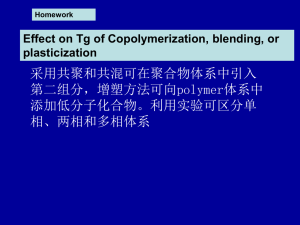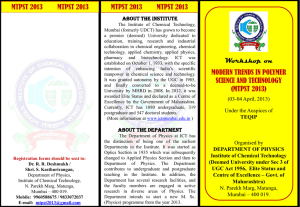478543.CHISA-2010_Bogdanic
advertisement
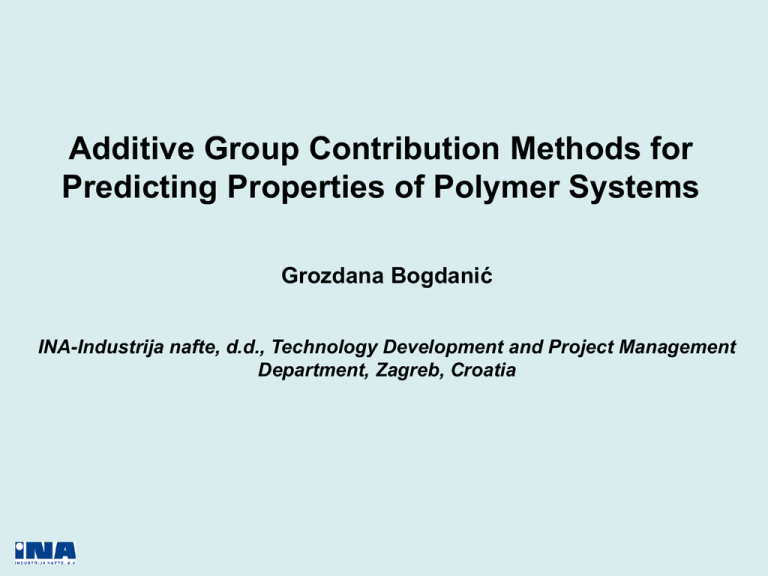
Additive Group Contribution Methods for Predicting Properties of Polymer Systems Grozdana Bogdanić INA-Industrija nafte, d.d., Technology Development and Project Management Department, Zagreb, Croatia 1. VLE 1.1. Group contribution methods for predicting the properties of polymer–solvent mixtures Activity coefficient models Equations of state 2. LLE 2.1. Group contribution methods for predicting the properties of polymer–solvent mixtures Activity coefficient models Equations of state 2. 2. Group contribution methods for predicting the properties of polymer–polymer mixtures (polymer blends) 3. Conclusions Group Contribution Methods for Predicting Properties of Polymer – Solvent Mixtures (VLE) wi mi mj j x iM i x jM j j ai = xi i = w i i The UNIFAC-FV model T. Oishi, J.M. Prausnitz, 1978. ln i = ln i comb combinatorial + ln i resid residual ~ 1/3 - 1 vi FV - Ci ln i = 3 C i ln 1/3 ~v M - 1 + ln i FV free-volume ~v i - 1 1 - 1 ~v ~v 1/3 M i 1 The Entropic-FV model H.S. Elbro, Aa. Fredenslund, P. Rasmussen, 1990. G.M. Kontogeorgis, Aa. Fredenslund, D.P. Tassios, 1993. ln i = ln i ln i entr = ln i FV +1- xi i entr + ln i attr FV xi i attr ln i The free-volume definition: v f, i = v i - v *i * i v = v w, i attr ( UNIFAC ) The GC-Flory EOS F. Chen, Aa. Fredenslund, P. Rasmussen, 1990. G. Bogdanić, Aa. Fredenslund, 1994. attr n RT ~v 1/3 + C E P = 1/3 + V ~v - 1 V comb + ln i combinatorial FV ln i = ln i FV + ln i attr attractive N. Muro-Suñé, R. Gani, G. Bell, I. Shirley, 2005. ln i FV ln i attr ln i comb = ln i xi = 3(1 + C i ) ln + 1 - i xi ~v 1/3 - 1 i - C i ln ~v 1/3 - 1 1 = 1/2 z q i [ ii ( ~v ) - ii ( ~v i )] + 1 - ln RT - j exp ( /RT) k ki j exp (- ji /RT) k j j ~v i ~v exp ( ji / RT ) The GC-lattice-fluid EOS M.S. High, R.P. Danner, 1989; 1990. ~ 2 ~ P z ~v + q/r - 1 v = ln + ln ~ ~ ~ ~ T 2 v T v -1 ~v 2 i, p ~v ( ~v i - 1) z qi i ln i = ln i - ln w i + ln ~ + q i ln ~ + q + ln ii ~ i ~ ~v v ( v 1) T 2 i Ti B.C. Lee, R.P. Danner, 1996. ln i = ln i - ln w i ~v 2 i,p z qi ~v ( ~v i - 1) i + ln ii + ln ~ + q i ln ~ - ~ + qi ~ ~ 2 v T vi Ti ( v - 1) G. Bogdanić, Aa. Fredenslund, 1995. UNIFAC-FV Entropic-FV GC-Flory GC-LF (1990) Prediction of infinite dilution activity coefficients versus experimental values for polymer solutions (more than 120 systems) B.C. Lee, R.P. Danner, 1997. Prediction of infinite dilution activity coefficients versus experimental values for systems containing nonpolar solvents (215-246 systems) B.C. Lee, R.P. Danner, 1997. Predictions of infinite dilution activity coefficients versus experimental values for systems containing weakly polar solvents (cca 60 systems) B.C. Lee, R.P. Danner, 1997. Predictions of infinite dilution activity coefficients versus experimental values for systems containing strongly polar solvents (cca 30 systems) G. Bogdanić, Aa. Fredenslund, 1995. T = 383 K T = 373 K T = 322 K Activity of 2-methyl heptane in PVC (Mn = 30000; Mn = 105000) Activity of ethyl benzene in PBD (Mn = 250000) Activity of MEK in PS (Mn = 103000) LLE Polymer solutions Polymer blends 2G 2 1 0 T ,P 2G 2 2 3G 3 2 0 ln 1 2 2 ln 1 2 0 The segmental interaction UNIQUAC-FV model(s) G. Bogdanić, J. Vidal, 2000. G.D. Pappa, E.C. Voutsas, D.P. Tassios, 2001. ln i = ln i ln i entr = ln entr i + ln i FV xi +1- i resid FV xi ncomp Xk xik (i) i ncomp nseg j x j m ( j) m nseg ln k Q k 1 ln m mk m nseg m m km nseg n a n m a n m , 1 a n m , 2 T T0 ln resid i k (i) k ln k ln (i) k n nm J. Vidal, G. Bogdanić, 1998. Correlation ( ) of LLE PEG/water system by the UNIQUAC–FV model G. Bogdanić, J. Vidal, 2000. Mv=65000 g/mol, correlation Mv=135000 g/mol, prediction Mw=44500 g/mol, - - - - prediction poly(S0.54-co-BMA0.46), Mw=40000 g/mol, correlation poly(S0.80-co-BMA0.20), Mw=250000 g/mol, - - - - prediction Correlation and prediction of LLE for PBD/1-octane by the UNIQUAC-FV model Correlation and prediction of LLE for poly(S-co-BMA)/MEK by the UNIQUAC-FV model The GC-Flory EOS G. Bogdanić, Aa. Fredenslund, 1994. G. Bogdanić, 2002. LLE parameters εnn , Δεnm G. Bogdanić, 2002. T /K T /K 4 00 42 0 3 75 3 50 M v =98000 41 0 M v = 191000 3 25 M v = 380000 3 00 40 0 M n =60400, M w = 82600 2 75 M n = 97700, M w =135900 M w = 180000 39 0 0.00 0.02 0.04 0.06 0.08 0.10 M a s s fra c tio n o f p o ly m e r Coexistence curves for HDPE/n-hexane systems as correlated by the GC-Flory EOS ( ) 2 50 0.00 0.05 0.10 0.15 0 .2 0 0.25 M a s s fra c tio n o f p o ly m e r Coexistence curves for PIB/n-hexane systems as correlated by the GC-Flory EOS ( ) The mean-field theory R.P. Kambour, J.T. Bendler, R.C. Bopp, 1983. G. ten Brinke, F.E. Karasz, W.J. MacKnight, 1983. GM R T = 1 N1 ln 1 + 2 N2 combinatorial ln 2 + blend 1 2 residual (A1-xBx)N1/(C1-yDy)N2: blend = ( 1 - x ) ( 1 - y ) AC + ( 1 - x ) y AD + x ( 1 - y ) BC + x y BD - x ( 1 - x ) AB - y ( 1 - y ) CD G. Bogdanić, R. Vuković, et. al., 1997. Miscibility of poly(S-co-oClS)/SPPO Miscibility of poly(S-co-pClS)/SPPO () one phase; () two phases; ( ) predicted miscibility/immiscibility boundary by the mean-field model G. Bogdanić, 2006. Miscibility behavior PPO/poly(oFS-co-pClS) system ( ------ ) correlated by the UNIQUAC-FV model Miscibility of SPPO/poly(oBrS-co-pBrS) system ( ) correlated by the UNIQUAC-FV model Why so many different models have been developed for polymer systems? The choice of a suitable model depends on: the actual problem and on the type of mixture type of phase equilibrium (VLE, LLE, SLE) conditions (temperature, pressure, concentration) type of calculation (accuracy, speed, yes/no answer, or complete design) Many databases and reliable GC-methods are available for estimating: pure polymer properties phase equilibrium of polymer solutions VLE: GC - models based on UNIFAC + FV GC - EOS LLE simple FV expression + local composition energetic term (UNIQUAC)
